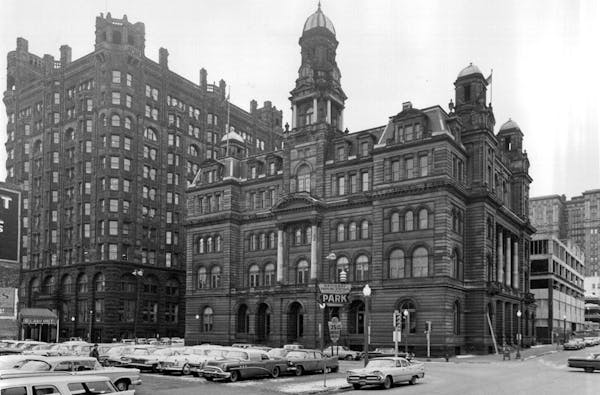In the early 20th century, Minnesota Gov. John A. Johnson embraced a rather unorthodox housing arrangement. He lived not in a mansion but in a residential hotel, the Aberdeen in St. Paul, occupying a sixth-floor suite that gave him a fine view of the new State Capitol.
The Aberdeen Hotel, built in 1889 and razed in 1944, was at Virginia Street and Dayton Avenue in what is now the Historic Hill District, and it served as an early example of a building type — the residential hotel.
Once very common in the Twin Cities, these hotel-apartment hybrids typically offered furnished rooms or suites of rooms that could be rented by the week or month, without the requirement of a long-term lease. Housecleaning was usually included with the rent, and some buildings also had their own restaurants with meal plans for tenants.
Unlike today's extended-stay hotels, the old residential hotels (most of which were located in or around downtown Minneapolis and St. Paul) catered to tenants who often remained for years, providing a large pool of affordable housing that has now largely dried up.
The bulk of the residential hotels in the Twin Cities were built between about 1890 and 1930. Some, like the Aberdeen, were designed for a wealthy clientele. The Aberdeen's suites ranged in size from two to eight rooms, and the hotel also offered a cafe and a ballroom. Besides Johnson, the Aberdeen's residents included Emmanuel Masqueray, architect of the Cathedral of St. Paul.
Most residential hotels, however, offered modest accommodations, with single- or two-room units predominating.
By my count, there were two dozen or more residential hotels in downtown Minneapolis alone by the 1920s. It's difficult to get an accurate count because some hotels that catered primarily to overnight guests also offered residential rooms. And as hotels aged, they often took on more residential tenants.
This was the case with a number of large downtown Minneapolis hotels such as the Curtis at 10th Street and S. 3rd Avenue and the Sheridan at 11th Street and Marquette Avenue.
One of the first true residential hotels to be built in downtown Minneapolis was the 400-room Hampshire Arms, which opened in 1892 at 900 4th Av. S.
Designed by William Channing Whitney, who specialized in mansions and buildings for the city's upper class, the Hampshire Arms was a straightforward five-story brick building organized around a grassy courtyard.
It offered one- to three-room units, a restaurant, maid service and what was said to be "a block-long roof garden." In ads, the hotel touted its "excellent dining room," "beautifully decorated modern apartments" and "central location."
One of the largest of Minneapolis' residential hotels was the Hastings, at N. 12th Street and Hawthorne Avenue. Built in 1912, it was a six-story brick structure — nothing fancy, but very solid looking. Like the Hampshire Arms, it provided a restaurant and housekeeping services, with "special rates" for those who stayed a month or longer.
The Hastings also offered an appealing amenity: a "private bath" with every room. This feature undoubtedly contributed to the popularity of residential hotels, especially those built after 1900. Before that time, people who couldn't afford houses or apartments typically lived in rooming houses or other group accommodations.
Finding room
Rooming houses — another all-but-vanished form of housing — were once scattered around the two downtowns. They were an example of what is today called naturally occurring affordable housing (NOAH), because many of them occupied old mansions.
Unlike residential hotels, rooming houses didn't offer much privacy and the bathroom was always down the hall, to be shared with everyone else in the household. And there were often nosy proprietors who kept an eye on the comings and goings of residents.
The stock of downtown rooming houses began to decline in the early decades of the 20th century, as more and more old mansions were torn down to make way for commercial development. By the 1950s, very few rooming houses were left in either downtown, but plenty of residential hotels remained in operation.
By then, however, no new residential hotels were being built. The postwar era focused on new single-family housing to the exclusion of almost everything else. And the hotels that remained often faced the usual problem of creeping decrepitude.
Today, residential hotels are mostly gone. The Hastings fell to the wrecker in 1969, the Sheridan in 1970, the Curtis in 1984 and the Hampshire Arms in 1985. Many others, now barely remembered, have also vanished: the Mark Twain on S. 2nd Avenue; the Plaza near Loring Park; the Berkeley at 12th Street and Marquette Avenue; the Wolf on St. Peter Street in St. Paul.
The few old residential hotels that still stand, like the Maryland at 1346 LaSalle Av., have been converted to either apartments or condominiums.
It's likely that a combination of factors — changing tastes, aging and poorly maintained buildings and relentless downtown development — probably spelled an end to the age of the residential hotel.
It's too bad. At a time when the most recently proposed residential tower in downtown Minneapolis will have units costing on average $1 million or more, the old residential hotels would be nice to have around, providing an increasingly precious commodity — affordable housing — in the decidedly upscale world of our downtowns.
Larry Millett is an architecture critic and author of 14 nonfiction books and eight mystery novels. He can be reached at larrymillett.com.









